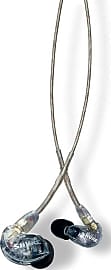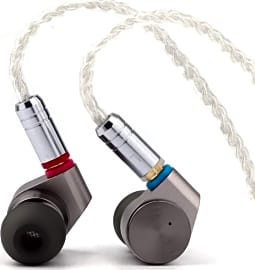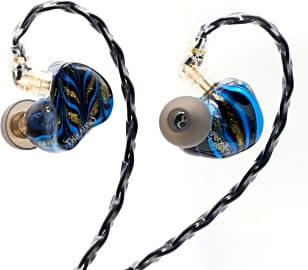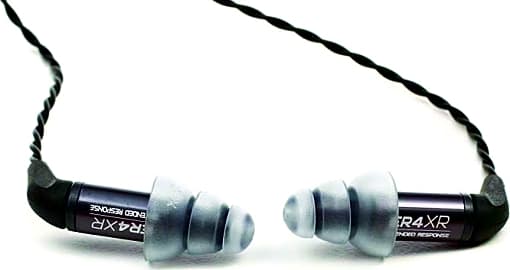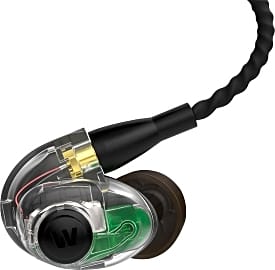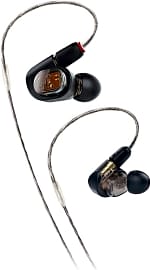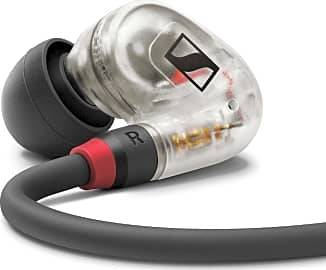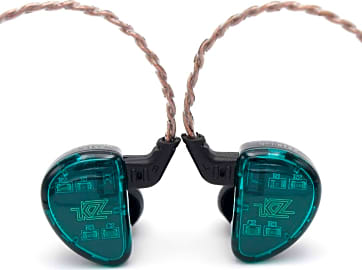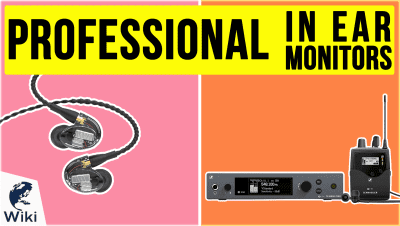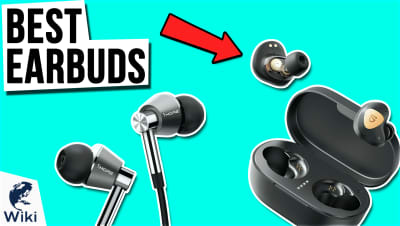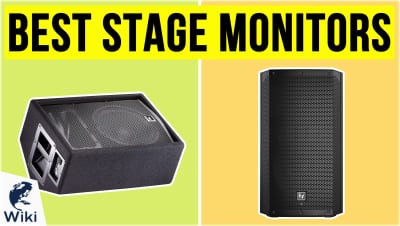The 10 Best In-Ear Stage Monitors

This wiki has been updated 38 times since it was first published in September of 2016. If you're a performer who likes to use the whole stage, and so can't always rely on foldback speakers, a set of in-ear monitors is your solution. They deliver great audio quality in a lightweight and comfortable package without altering the sound profile, so you can strut your stuff with abandon. They can also serve double-duty as your regular earphones for music and videos, as well. When users buy our independently chosen editorial recommendations, we may earn commissions to help fund the Wiki.
Editor's Notes
December 09, 2020:
We decided to stop recommending the Sennheiser IE 800S and Ultimate Ears Reference models because they're exorbitantly expensive, and most users with such high standards and budget have a relatively specific set of needs. They're still great options, but there are some other very good choices that cost considerably less. If you're still interested in ultra-premium IEMs, though, there's no shortage of worthwhile choices.
To replace those fantastic yet wildly expensive models, we chose a couple that have an interesting, modern heritage, something we want to draw attention to. Some manufacturers, like those of the Fiio FH5, Audio-Technica ATH-E70, and Sennheiser IE 40 Pro, are known for their consumer- and professional-grade audio lines. Others, such as the makers of the Westone Clear AM Pro 30, Etymotic Research ER4XR, and Shure SE215, are basically famous for their gig-quality equipment and teams of engineers dedicated to high-level acoustic performance.
Then there's the relatively upstart world of affordable, Chinese-made IEMs. These are often known affectionately as "Chi-Fi," and far from being a negative, there's a decently huge field of these that perform on the level of models many times more expensive. The Blon BL-03 and KZ AS10 are two prominent examples, and for this edition of our rankings, we added the Thieaudio Legacy 3, which is one of the most interesting mid-level models recently released. We also highly recommend the Tin T2, and in fact many musicians and listeners will prefer them over their relatives the T2 Pro and T3. Their natural sound profile and precise response should impress all but the absolute pickiest listeners, despite their surprisingly low cost.
December 06, 2019:
First of all, in-ear monitors aren't generally intended for casual listening like everyday earbuds are -- they're intended to replace actual stage monitor wedges while performing. That said, we decided to cap our search in terms of price, because after a certain range, IEM selection becomes extremely subjective, and there are hundreds of insanely expensive options that would be impossible to parse. In that light, it's easy to argue that the Ultimate Ears Reference Remastered and Sennheiser IE 800S are some of the best universal choices no matter what kind of music you play. The only drawback is that they both cost an incredible amount. Slightly less expensive are the Westone Clear AM Pro 30 and Audio-Technica ATH-E70; the Westones very much uphold the brand's legacy of high-performance on-stage audio, while the ATH-E70s punch well above their weight class and deliver a clear and balanced sound at all levels.
If you're not interested in paying out the nose, you still have some great options to choose from. Possible the best balance of price and performance, the Fiio FH5 are somewhat of an investment, but are almost universally beloved by performers and casual listeners alike. The Etymotic Research ER4XR are similarly priced and are especially notable for their exceptional isolation. If you've ever searched for professional IEMs before, you've almost certainly run across the Shure SE215, which are so widely used that they're practically the industry standard. For the money, it's hard to find a more versatile choice that all band members will appreciate, and everyone having the same set of monitors can go a long way in properly mixing live sound. And while not everyone prefers them, the Sennheiser IE 40 Pro are an excellent choice if the Shure model isn't right for you.
On the budget-friendly side of things, both the KZ AS10 and Blon BL-03 are worth a look, as they provide nearly the sound quality of far more expensive models at considerably lower prices, due in part to their relatively unknown manufacturers. One of the drawbacks of these is that they do not use MMCX connectors but rather a less popular format, but with a little searching you can certainly find a high-quality replacement or upgrade cable, should you feel the need.
Special Honors
Ultimate Ears Pro If you're looking for the best of the best, many professionals will argue that they come from Ultimate Ears. A far cry from their audiophile-grade headphones and popular Bluetooth speakers, this line of high-end custom in-ear monitors has something for everyone -- except anyone who isn't willing to shell out a bunch of cash. pro.ultimateears.com
Jerry Harvey Audio JH Audio has an extensive collection of in-ear monitors that are used by quite a few touring musicians, who tend to be very demanding. These powerful IEMs are durable, lightweight, and outfitted with some of the best audio technology there is. You'll probably want to find a licensed dealer and try out a few pairs before deciding on one, because a pair of JH Audio IEMs represents a relatively massive investment. jhaudio.com
Jomo Audio Jomo makes some fantastic universal IEMs, and their dedication to high quality and natural sound make their custom-fit models even more impressive. They have a few different options to choose from, all of which cost an arm and a leg, but once you settle on the right one for you, it may be the last pair of monitors you ever need to purchase. jomoaudio.com
An Experience Like No Other
Of course, you love to perform, and no one needs to sell you on that.
It's a feeling well-known to artists. Few things in life match the sensation of performing on stage in front of hordes of excited fans. As the house lights go down, the spotlights warm up, and the eager audience looks up at the band, everything can seem in perfect harmony leading up to the opening number. You've practiced for weeks, and this tour could make or break your album sales for the next year. Naturally, you're prepared to play the show of your life.
And it's good that you are — not least of all because many performers feel they have a duty to the people who showed up to provide them with an engaging and entertaining show. Aside from the showman's responsibility, it's not terribly shocking to learn how playing music is great for the health of the musicians themselves. It aids in cognitive function (that's your ability to think) across the board as it activates almost every center of your brain. Musicianship can also lower levels of stress-inducing chemicals and it may even help fight some forms of dementia. In fact, learning an instrument physically strengthens critical coordination and thought processing areas. And if you avoid falling into the traditionally unhealthy traps of being on tour (primarily: fast food, sitting around too much, and drinking alcohol), performing is even physically healthy, engaging your entire body from your back to your breathing.
Of course, you love to perform, and no one needs to sell you on that. Whether your audience is dancing, moshing, or dropping their jaws in awe at your virtuosity, the knowledge that you've successfully entertained the masses is incredibly satisfying. But when your band strikes up, there's one issue that's paramount to the quality of the show: can you hear the sounds that you and your bandmates are making, and are they clear and balanced?
Can I Hear Myself?
This is a question that performers have struggled with since the earliest days of electrified music. It takes a pretty big set of speakers to pump out enough sound to fill that historic downtown theater packed with 2,000 fans or more. And, let's be honest, some sound systems and their engineers are of better quality than others. Not every line stack will deliver the same mid-range clarity and distinct bass as a top-shelf, handmade d&b-branded system imported straight from Germany. And not every bar manager will be able to coax your band's best sound out of their dated soundboard.
If players are moving around the stage or switching instruments, those specialized mixes will become muddy and hurt everyone's ability to pick out their own sound.
The monitors stacked on the front of the stage at most concerts are there to return the sound straight to the band. In theory, this feed is separate from the actual house audio. In practice, however, large speaker stacks are often placed behind the performers, and this can really impair monitor sound in larger venues. Plus, the sound engineer is busy enough these days checking the sound from every angle in the venue using their tablet to wirelessly control the in-house sound system. The last thing he or she has time to do is readjust monitors mid-set when the dynamics turn from intense to intimate.
This adds to a couple issues with standard wedge-based monitoring systems. Individual wedges are equalized based on who they're in front of, i.e. the bassist, drummer, or rhythm guitarist. If players are moving around the stage or switching instruments, those specialized mixes will become muddy and hurt everyone's ability to pick out their own sound. Beyond that, as the massive speakers behind the band get loud, and monitor speakers in front begin to peak, it's certainly not helping the long-term hearing health of everyone on stage.
So how do you channel the clearest monitor of your playing straight to your ears, in real-time, without worrying about levels, feedback, buzzing, or cables? How can you put your whole group's contributions in your own head as you play for the crowd? There's already a ton of equipment positioned around most bands while they play, even if everybody uses wireless instrument and microphone setups. How, then, does the modern musician reduce stage clutter while also making their performance life easier? And how, for example, can a professional horn player hear a monitor mix where his sound actually comes through, without hurting his bandmates' ears in the process?
Simple: they strap a receiver to their body, hang a speaker in their ear, and get ready to play in circles around the stage.
Not Your Everyday Earbuds
An in-ear monitoring system consists of three parts: the transmitter, receiver, and the earphone itself. As with many wireless systems, the transmitters do have limitations. Interference from on-stage equipment, bandwidth interference due to multiple members using close frequencies, and the raw distance from the transmitting unit can all negatively affect the signal that your wireless beltpack receiver pulls from the airwaves. Over the last decade, though, technologies like beamforming and audio compression have made wireless more effective and affordable than ever. Still, at the end of the day, you want to be certain that the sound in your monitor is true to the sound that's filling up the concert hall.
Don't be fooled by a bunch of products that might just look like expensive earbuds. These units are designed specifically to provide a faithful reproduction of the analog data they're fed. They're made with comfort and sonic accuracy foremost in mind, many including different sizes of silicone tips. Some models can be custom fit to your ear, ensuring long-term wearability as well as a perfect seal, keeping even the most subtle sounds channeled directly to your eardrum. Light weight and active noise cancellation are two other features found on most in-ear options. Above all, good monitor earpieces are made with the quality materials and craftsmanship that let you jam out on-stage for hours at a time, while hearing yourself with crystal-clear precision.


